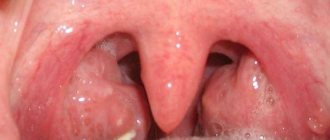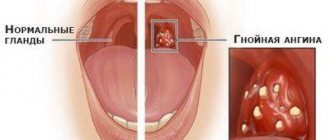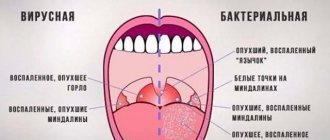Rehabilitation after tonsillectomy: what you can eat, how much your throat hurts, treatment
Recovery after tonsillectomy lasts several weeks and requires strict adherence to your doctor's recommendations.
During this period, due to swelling of the pharyngeal tissues, pain and a feeling of a foreign body in the throat occur. Caring for a person after surgery to remove tonsils involves proper nutrition. Limiting physical activity and proper daily routine speed up recovery.
Immediately after removal of the lymphoid tissue, there are wounds in the throat. To prevent bleeding, the patient is placed on his side and offered a paper towel to spit out sputum. Throughout the first day, the patient follows several important rules:
- You can't talk for 24 hours. Vocal rest helps to quickly restore the laryngeal ligaments.
- Lying down prevents bleeding.
- You can't eat.
- Adults are allowed to drink sweetened tea at room temperature.
- It is recommended to drink plenty of fluids.
- Small children can eat thin porridge and milk jelly.
- To relieve a sore throat after surgery to remove the tonsils, an injection of an anesthetic is given.
- On the first day, the patient should not swallow saliva, but should spit it out.
- Oral hygiene must be observed very carefully, trying not to damage the mucous membranes.
Upon discharge, the patient is given a leaflet with recommended dietary intake. In the postoperative period, it is necessary to strictly follow the doctor's instructions.
Advice! On the first day you cannot go to the bathhouse, sauna, solarium, or take a hot shower. Drinking alcohol and smoking is prohibited. Tobacco smoke is very irritating to the operated area. On the day of the operation, air travel is prohibited.
Second day
The next day after surgery, the patient needs to talk a lot so that adhesions do not form.
For several days after surgery on the tonsils, the risk of bleeding remains. For the prevention and disinfection of the oral cavity, it is allowed to gargle with 3% Hydrogen Peroxide, diluted in a proportion of 1 tbsp. l. pharmaceutical product in half a glass of warm water.
The doctor gives nutritional recommendations, describing what you can eat after tonsil removal. The diet consists of mechanically and thermally gentle dishes:
- a variety of fruit non-acidic juices;
- puree;
- sour cream and milk;
- slimy soups;
- soaked bread and cookies;
- vegetables and fruits pureed in a blender.
The basic rules of the second day are frequent but small meals with limited salt. Each serving should not exceed 400 grams for 6 meals.
On the third day after surgery, sore throat intensifies in all patients. This is due to the process of regeneration and the formation of granulation tissues. Therefore, nutrition after removal of the tonsils during this period remains gentle. The diet includes dishes:
- cottage cheese pureed with milk, cream;
- boiled porridge in water, meat broth or milk;
- semolina soup;
- meat broth;
- fish puree;
- eggs in a bag or steamed;
- steamed meat, chicken and fish;
- baked vegetables.
After removing the tonsils, it is important not only to prevent infection of the postoperative wound, but also to provide the body with the necessary nutrients. The speed of regeneration depends on the state of the immune system and the method of surgery.
Although the sore throat has subsided during this period, the wound surface is still irritated and the risk of bleeding remains. The diet after removal of the tonsils in adults and children includes varied but gentle dishes.
The diet after tonsil removal has a number of features. Until the pain and discomfort in the throat completely disappears, patients should adhere to the following rules:
- It is recommended to take the food cold;
- food intake should be fractional - in small portions, but more often than usual;
- before lunch and dinner it is allowed to take anesthetics to relieve pain;
- food should be soft, without hard lumps;
- dishes should only be steamed;
- After removal of the tonsils, it is recommended to eat ice cream to reduce pain and stop bleeding.
Drinks and foods that irritate the throat - sauces, marinades, sharp cheeses - are excluded from the diet. It is necessary to avoid fatty, canned foods. The menu should be balanced so that the patient receives nutrients without weakening the body.
The postoperative period on the third day after removal is characterized by increased pain at the site of the tonsils. This is due to fibrin deposition.
Over the next 6 days, epithelial cells form in the place where the tonsils were. The tissue healing process is accompanied by the deposition of white plaque, which disappears by the end of the week.
Important! After any type of surgery, pain persists for 2 weeks. Throughout this period, the patient must carefully monitor his throat, following the recommendations for the use of medications. It is just as important to follow a diet.
Full recovery after tonsillectomy lasts 22–23 days. By this time, the wound has healed, acquiring a homogeneous structure. In the place where the palatine tonsils were, new mucous membranes form. In children, recovery occurs faster. In addition, they tolerate surgery more easily.
In addition to proper nutrition, the operated patient undergoes a full course of drug therapy. Complex treatment includes the following drugs:
- Antibiotics prevent the proliferation of pathogenic bacteria.
- Immunostimulants accelerate the production of natural protective substances and increase the body's resistance to bacteria and viruses.
- Coagulants promote blood clotting, which is necessary to prevent bleeding.
- Nonsteroidal anti-inflammatory drugs reduce sore throat and eliminate swelling of the pharyngeal tissue.
- Vitamins stimulate the regeneration of cells in the operated area and accelerate metabolic processes.
Antibiotics are prescribed only by a doctor for 7–10 days. Do not interrupt the course of treatment or change the dosage. Drugs are selected depending on the patient’s condition and contraindications.
Removal of tonsils during the rehabilitation period is accompanied by an increase in temperature to 37.0–37.5 °C and an increase in cervical and submandibular lymph nodes. This reaction of the body indicates recovery processes.
Proper nutrition helps restore strength and speed up healing after tonsillectomy surgery. The diet should be complete, but gentle.
Steamed dishes prevent irritation of wounds and prevent increased pain. Recovery occurs much faster if you follow the doctor’s recommendations and give up bad habits.
Indications for tonsillectomy
If a child suffers from sore throats and colds very often, tonsil removal may be necessary.
Indications for tonsillectomy are determined by a specialist during diagnosis of the patient. Without them, not a single doctor will recommend that a patient agree to surgery.
Tonsillectomy is an operation that involves complete excision of the tonsils. The connective tissue capsule must also be removed.
Excision of the palatine tonsils is required if the following indications exist:
- Sore throat, which bothers a person more than 7 times a year.
- Lack of results after conservative treatment.
- Chronic tonsillitis of decompensated type.
- Complications of an infectious-inflammatory nature that spread to neighboring organs.
- An increase in the size of the tonsils, due to which a person cannot swallow and breathe normally.
In most cases, tonsillectomy in children is performed due to decompensated tonsillitis. Conservative therapy does not allow one to cope with the disease, so doctors are forced to take extreme measures to save the child.
The reason for removal of the palatine tonsils are pathologies that lead to breathing problems. Indications include inflammatory diseases of the bronchi and lungs, streptococcal infections and abscesses.
What foods are best to avoid and why?
In the ranking of the most dangerous dishes, hot first courses and drinks take first place. Hot drinks are generally contraindicated for people after surgery, since bleeding may resume at any time in the places where there were wounds.
This is achieved by expanding the circulatory system, which the pharynx is abundantly supplied with. Cold food, on the contrary, can be consumed in large quantities without fear of the possibility of hypothermia of the respiratory system.
In third place are strong alcoholic drinks, as well as non-alcoholic, but highly carbonated drinks and cocktails. These fluids can negatively affect the larynx, depriving it of its last chance to fully perform its functions.
You should especially not drink carbonated liquids when the treatment is not yet completed, because open wounds irritated by gases take longer to heal and constantly bleed. In fact, even for those who are the proud owner of almonds, excessive alcohol intake is harmful, so a healthy lifestyle is important not only when there is nothing left to save, but also when there is something to be proud of.
The fact is that a high content of acids and salts also has a detrimental effect on the mucous membrane, especially if such food is consumed in the first two weeks after surgery. Sweets will also become prohibited, but their infrequent consumption will not cause noticeable harm.
How to eat without tonsils?
People who have had their tonsils partially or completely removed need to be careful about their lifestyle after treatment is completed. Since there are now no natural filters, there is a high probability of frequent respiratory diseases. A key factor in building a healthy lifestyle is nutrition, which excludes some dishes altogether.
People who have undergone a tonsillectomy must adhere to the following rules:
- Drink more fluids, since dry throat mucosa several times increases the risk of pathogenic microorganisms getting inside, provoking inflammatory processes.
- Nutrition should be complete, fortified, with a high content of protein foods.
- Avoid drinking hot foods, especially liquids such as tea and coffee.
In fact, the nutrition of a person without tonsils is no different from the general recommendations for proper nutrition, however, there are some nuances that simply must be observed.
The diet must include foods such as:
- Cereals - porridges perfectly satisfy hunger, and they can be made in liquid pureed form.
- Protein foods - milk and fermented milk products - contribute to the normalization of all human life processes, while softly enveloping the mucous membrane. Meat should initially be consumed in pureed, minced form, preferably steamed or boiled.
- Drinking plenty of fluids can keep the water balance normal, and frequent irrigation of the mucous membrane contributes to its better functioning.
Video: Tonsillectomy. Types of surgery. We treat correctly with Vladimir Zaitsev
Source
Recovery after tonsillectomy lasts several weeks and requires strict adherence to your doctor's recommendations. During this period, due to swelling of the pharyngeal tissues, pain and a feeling of a foreign body in the throat occur.
Caring for a person after surgery to remove tonsils involves proper nutrition. Limiting physical activity and proper daily routine speed up recovery.











